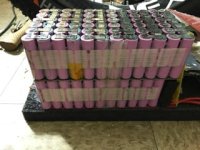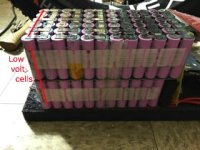slippery410
100 µW
- Joined
- Mar 16, 2017
- Messages
- 9
Hi guys.
My first post on this forum and Id like to start by saying thanks in advance to reading as well as posting to me thread.
Ive been wanting to build an bike for some time now but with a family and one on the way, its a luxury I could only hope to one day have for my own. A few of my friends have bikes and every now again I get to enjoy theirs.
Good friends indeed, as Joe Cocker once said, "Anything is possible with a little help from your friends. Well my buddy looked out for me big time. He was rebuilding one of his bikes and upgraded the motor and controller. He could have sold the pair without a problem and instead opted to gifting me with them. All my other friends with bikes were there that managed to scrape up all the other parts to nearly complete a bike. So if you guys are reading, Thanks Again! Love you guys.
My final bud gifted me with a battery. Big one. But he says theirs a problem with it. Says he shorted out the bms to the pack a few months back. Rather then take the time it would take to repair, he purchased an even bigger pack which is what he wanted to do anyway. He never got around to having it repaired so he gave it to me in hopes I could use it for my bike.
He removed the bms and sat it on a shelf till now.
He wanted to see how balanced the cells were so we pulled out the Multimeter and took a few reading for you guys to judge
23s pack 6 cell group. Voltage taken from each cell group:
1- 4.207v 2- 8.401v 3- 12.59v. 4- 16.81v. 5- 21.01v. 6- 25.21v. 7- 29.41v 8- 33.62v. 9- 37.83v. 10- 42.03v. 11- 46.23v. 12- 49.91v. 13- 53.29v
14- 57.5v. 15- 61.72v. 16- 65.93v. 17- 70.2v. 18- 74.4v. 19- 78.6v. 20- 82.8v. 21- 87.v. 22- 91.2v 23- 95.4v
The cells are INR18650-30Q Samsung SDI 136
What id like to know if these are safe ranges from one cell to the next to adapt a bms to this pack as well as any recommendations as far as a bms.
Im not too keen on handling such a powerful pack so if anyone could recommend some place that could service this pack would be a great help as well...
Thanks again guys and with a little luck Ill be E grinning all the time.
My first post on this forum and Id like to start by saying thanks in advance to reading as well as posting to me thread.
Ive been wanting to build an bike for some time now but with a family and one on the way, its a luxury I could only hope to one day have for my own. A few of my friends have bikes and every now again I get to enjoy theirs.
Good friends indeed, as Joe Cocker once said, "Anything is possible with a little help from your friends. Well my buddy looked out for me big time. He was rebuilding one of his bikes and upgraded the motor and controller. He could have sold the pair without a problem and instead opted to gifting me with them. All my other friends with bikes were there that managed to scrape up all the other parts to nearly complete a bike. So if you guys are reading, Thanks Again! Love you guys.
My final bud gifted me with a battery. Big one. But he says theirs a problem with it. Says he shorted out the bms to the pack a few months back. Rather then take the time it would take to repair, he purchased an even bigger pack which is what he wanted to do anyway. He never got around to having it repaired so he gave it to me in hopes I could use it for my bike.
He removed the bms and sat it on a shelf till now.

He wanted to see how balanced the cells were so we pulled out the Multimeter and took a few reading for you guys to judge
23s pack 6 cell group. Voltage taken from each cell group:
1- 4.207v 2- 8.401v 3- 12.59v. 4- 16.81v. 5- 21.01v. 6- 25.21v. 7- 29.41v 8- 33.62v. 9- 37.83v. 10- 42.03v. 11- 46.23v. 12- 49.91v. 13- 53.29v
14- 57.5v. 15- 61.72v. 16- 65.93v. 17- 70.2v. 18- 74.4v. 19- 78.6v. 20- 82.8v. 21- 87.v. 22- 91.2v 23- 95.4v
The cells are INR18650-30Q Samsung SDI 136
What id like to know if these are safe ranges from one cell to the next to adapt a bms to this pack as well as any recommendations as far as a bms.
Im not too keen on handling such a powerful pack so if anyone could recommend some place that could service this pack would be a great help as well...
Thanks again guys and with a little luck Ill be E grinning all the time.




